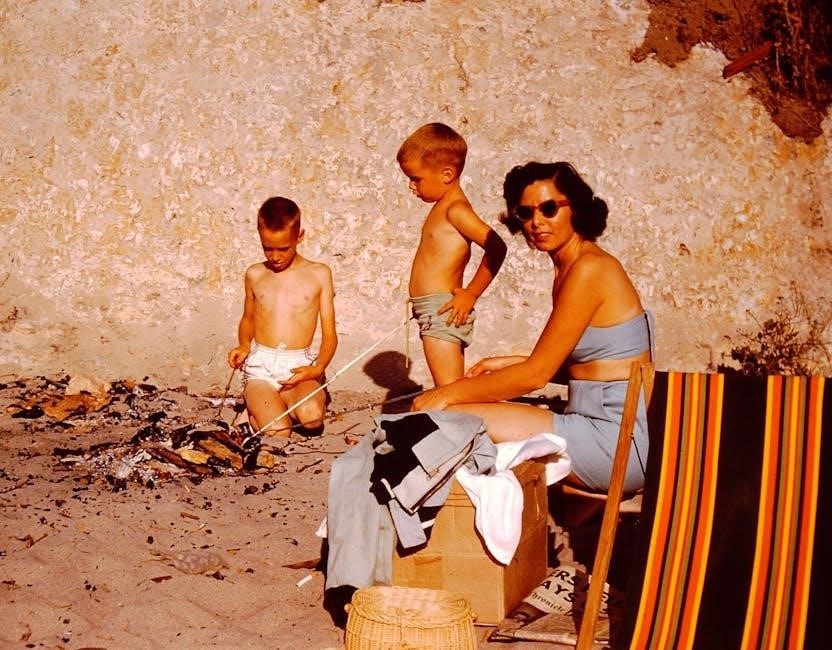Doubt: A Parable, a Pulitzer Prize-winning play by John Patrick Shanley, explores themes of faith, morality, and uncertainty in a 1964 Bronx Catholic school, sparking intense psychological tension and moral debate that lingers long after the curtain falls.
1.1 Overview of the Play
Doubt: A Parable, written by John Patrick Shanley, is a compelling drama set in a Catholic school in the Bronx during the 1960s. The play revolves around Sister Aloysius Beauvier, the strict principal, who suspects Father Brendan Flynn, a progressive priest, of abusing a male student. The narrative unfolds through tense interactions between the characters, exploring themes of faith, doubt, and moral ambiguity. Sister James, a young and naive nun, becomes entangled in the conflict, further complicating the dynamics. Through sharp dialogue and psychological depth, the play challenges the audience to question truth, authority, and certainty. Its concise yet powerful structure leaves a lasting impact, making it a thought-provoking exploration of human morality and belief. The Pulitzer Prize-winning drama has been widely acclaimed for its nuanced storytelling and its ability to provoke reflection long after the final scene.
1.2 Availability of the Play in PDF Format
Doubt: A Parable is widely available in PDF format, accessible through various online platforms. Sources like Script Slug, The Script Savant, and Scribd offer downloadable versions of the play. Additionally, educational institutions and theater groups often provide access to the script for study or production purposes. The PDF format allows readers to delve into John Patrick Shanley’s powerful dialogue and nuanced character development at their convenience. Whether for academic analysis or personal reading, the play’s digital availability ensures its reach extends beyond the stage. Users can easily locate and download the PDF through online searches, making Doubt: A Parable readily accessible to a global audience interested in exploring its profound themes and complex characters.
Background and Context
Doubt: A Parable is set in 1964 at St. Nicholas Catholic School in the Bronx, exploring themes of faith, doubt, and moral uncertainty amidst societal change, reflecting its Pulitzer Prize-winning acclaim.
2.1 Historical Setting of the Play
Doubt: A Parable is set in 1964 at St. Nicholas Catholic School in the Bronx. This period reflects societal shifts post-Vatican II, influencing the Church’s role. The Bronx’s cultural diversity and economic challenges provide a vivid backdrop for the story’s tensions. The play captures the essence of a community grappling with change, where traditional values collide with modern perspectives. The historical context underscores the moral and ethical dilemmas faced by the characters, creating a rich tapestry of conflict and introspection. The setting is pivotal in shaping the characters’ motivations and the play’s overarching themes of doubt and certainty.

2.2 Cultural and Religious Context

Doubt: A Parable is deeply rooted in the cultural and religious fabric of 1960s America, particularly within the Catholic Church. The play reflects the post-Vatican II era, where traditional Church practices were being questioned, and modernity was influencing religious life. The Bronx setting, with its diverse Irish-Italian community, adds a layer of cultural complexity. The strict hierarchical structure of the Church is central to the narrative, as it explores the power dynamics between nuns and priests. The play critiques the Church’s rigid moral framework while highlighting the moral ambiguity faced by its characters. The cultural and religious context shapes the characters’ beliefs, actions, and conflicts, creating a nuanced exploration of faith, doubt, and authority. This backdrop is essential to understanding the play’s themes and the psychological tension between its characters. The setting amplifies the moral and ethical dilemmas, making the story both timeless and deeply rooted in its era.

2.3 The Pulitzer Prize Win
Doubt: A Parable earned widespread acclaim when it won the Pulitzer Prize for Drama in 2005. This prestigious award highlighted the play’s masterful exploration of faith, doubt, and moral ambiguity. The Pulitzer Prize not only cemented the play’s reputation as a modern classic but also brought it to a broader audience. John Patrick Shanley’s nuanced storytelling and complex characters resonated deeply with critics and audiences alike. The play also received a Tony Award for Best Play, further solidifying its impact on American theater. The Pulitzer Prize win underscored the play’s ability to provoke thought and spark dialogue about universal themes. It remains a landmark work in contemporary drama, celebrated for its psychological depth and its unflinching examination of human frailty and uncertainty. The recognition continues to influence its study and performance, ensuring its lasting legacy in the world of theater.
Themes and Analysis
Doubt: A Parable delves into themes of uncertainty, faith, and moral ambiguity, weaving them through characters’ journeys to challenge perceptions of truth and belief, leaving a lasting emotional and intellectual impact.
3.1 The Theme of Doubt
The play’s title reflects its core theme: doubt. This emotional and psychological state permeates every character’s journey, creating tension and uncertainty. Sister Aloysius’s suspicion of Father Flynn’s behavior exemplifies this, as her rigid adherence to discipline clashes with her inner uncertainty. Doubt is not merely a lack of faith but a catalyst for questioning authority and truth. Through Father Flynn’s charisma and Sister James’s naivety, the play shows how doubt can both unite and divide. The audience is left questioning the characters’ motivations and the truth, mirroring the characters’ own struggles. This exploration of doubt makes the play a profound examination of human frailty and the complexity of belief, leaving a lasting impact on the audience’s perception of certainty and ambiguity.
3.2 The Role of Morality and Ethics
Morality and ethics are central to the play, as characters grapple with right and wrong in a rigid Catholic school environment. Sister Aloysius’s strict adherence to tradition and discipline contrasts with Father Flynn’s more compassionate approach, creating ethical tension. The play challenges the audience to question authority and the motivations behind moral decisions. Themes of justice, responsibility, and the consequences of actions are explored through the characters’ interactions. The ethical dilemma of accusing someone without certainty raises questions about fairness and the impact of assumptions. This moral complexity makes the play a thought-provoking exploration of ethical behavior, highlighting the challenges of making difficult decisions and the importance of integrity in uncertain situations. The interplay of morality and ethics adds depth to the narrative, leaving a lasting impression on the audience.
3.3 Power Dynamics and Authority

Power dynamics and authority are pivotal in Doubt: A Parable, as the rigid hierarchy of the Catholic Church and school setting creates tension between characters. Sister Aloysius, as the principal, wields significant authority, using it to enforce her strict moral code and investigate Father Flynn. Her dominance contrasts with Sister James’s subordinate role, showcasing the imbalance of power among the nuns. Father Flynn, as a priest, holds religious authority, but Sister Aloysius questions his moral standing, challenging the traditional power structure. This clash highlights the struggle for control and the consequences of questioning authority. The play examines how power can be both abused and contested, reflecting broader societal issues of authority and accountability. Through these dynamics, Shanley critiques the rigid structures of the Church and the impact of unchecked power on individuals and communities, adding layers of complexity to the narrative.
Character Analysis
The play revolves around four complex characters: Sister Aloysius, the rigid principal; Father Flynn, the charismatic priest; Sister James, the naive nun; and Donald Muller, the vulnerable student. Their interactions and conflicts drive the narrative, exploring themes of doubt, power, and morality.
4.1 Sister Aloysius Beauvier
Sister Aloysius Beauvier is the stern and rigid principal of St. Nicholas Church School. Her unwavering commitment to discipline and tradition often clashes with the changing values of the 1960s. Driven by a deep sense of duty, she suspects Father Flynn of improper behavior with Donald Muller, a student. Her certainty in her convictions leads her to confront Father Flynn, despite lacking concrete evidence. Sister Aloysius sees herself as a protector of the children, but her methods are harsh and unyielding. Her character embodies the tension between faith and doubt, as she struggles with her own moral ambiguities. Through her, the play explores themes of authority, morality, and the complexities of human judgment.
4.2 Father Brendan Flynn
Father Brendan Flynn is a charismatic and progressive priest at St. Nicholas Church, whose modern views on faith and education clash with Sister Aloysius’s traditional methods. He advocates for a more compassionate and approachable form of Catholicism, which resonates with the students but raises suspicions. His friendly demeanor and efforts to connect with the children, particularly Donald Muller, lead Sister Aloysius to accuse him of improper conduct. Despite his denials, the lack of concrete evidence leaves the audience questioning his innocence. Father Flynn represents the tension between old and new values in the Church, embodying the play’s exploration of doubt and moral ambiguity. His character challenges the audience to confront their own biases and the complexities of human behavior.
4.3 Sister James
Sister James is a young and idealistic nun who serves as a teacher at St. Nicholas School. Her innocence and naivety often place her at odds with the harsh realities of the world, as personified by Sister Aloysius; Initially, Sister James is torn between her loyalty to Father Flynn and her growing unease about his behavior, which Sister Aloysius brings to her attention. Her character represents the struggle between faith and doubt, as she grapples with the moral complexities of the situation. Through her interactions with both Sister Aloysius and Father Flynn, Sister James evolves from a state of uncertainty to one of greater self-awareness, ultimately becoming a key figure in the play’s resolution. Her journey reflects the broader themes of the play, as she learns to navigate the challenges of her vocation and the ambiguities of human nature.

Script and PDF Resources
Doubt: A Parable scripts and PDFs are widely available online, with versions accessible via platforms like The Script Savant, Script Slug, and Script Fly, offering comprehensive study guides and scripts for easy download and analysis.
5.1 Where to Find the PDF Version
The PDF version of Doubt: A Parable can be found on various online platforms, including The Script Savant, Script Slug, and Script Fly. These websites offer free downloads of the play’s script, making it easily accessible for readers and scholars. Additionally, the PDF is available through platforms like the Internet Archive, where it is part of their extensive collection of dramatic works. The document is also accessible via educational resources and study guides, which often include detailed analyses and summaries. For those seeking a direct download, the PDF can be found at gregoryberry.net. These sources provide a comprehensive and convenient way to explore Shanley’s Pulitzer Prize-winning play in digital format.
5.2 Differences Between Script and Play
While the script and play of Doubt: A Parable share the same narrative core, there are notable differences in their formats and purposes. The play is traditionally performed on stage, relying heavily on dialogue, stage directions, and the dynamic interaction between actors and audience. In contrast, the script is a written version, often used for study or pre-production, and includes detailed descriptions of settings, character actions, and scene transitions. The PDF version available online mirrors the script, offering a static representation of the story. However, it lacks the immersive experience of a live performance, which brings the characters and their conflicts to life. These differences highlight the dual nature of the work, serving both as a literary piece and a theatrical experience, each enriching the understanding of Shanley’s exploration of doubt and morality.

Performance History and Adaptations
Doubt: A Parable premiered Off-Broadway in 2004, transferring to Broadway in 2005, where it won the Pulitzer Prize and Tony Awards. Its success led to a 2008 film adaptation starring Meryl Streep, further cementing its impact.
6.1 Original Broadway Production

The original Broadway production of Doubt: A Parable opened at the Walter Kerr Theatre in March 2005, following its successful Off-Broadway run. Directed by Doug Hughes, the play starred Cherry Jones as Sister Aloysius Beauvier, Brian F. O’Byrne as Father Brendan Flynn, and Heather Bancroft as Sister James. The production received widespread critical acclaim for its intense performances and thought-provoking themes. It ran for 525 performances, closing on July 2, 2006. The play’s Broadway success was a testament to its powerful storytelling and its ability to spark moral debate among audiences. The production also earned numerous awards, including the Pulitzer Prize for Drama and four Tony Awards, solidifying its place as a landmark work in contemporary theater.
6.2 Notable Adaptations and Revivals
Doubt: A Parable has seen numerous adaptations and revivals since its Broadway debut, further cementing its impact on theater and culture. A notable adaptation was the 2008 film version, directed by John Patrick Shanley, featuring Meryl Streep, Philip Seymour Hoffman, and Amy Adams, which garnered several Academy Award nominations. The play has also been revived in various regional theaters worldwide, including a 2025 production by Possum Point Players, directed by J. Denise Baker, which highlights its enduring relevance. Each revival brings fresh perspectives to the characters and themes, ensuring the play remains a vital part of contemporary theater discourse. These adaptations and revivals underscore the universality of doubt and moral ambiguity, resonating with audiences across different mediums and generations.

Relevance and Impact
Doubt: A Parable remains culturally significant, exploring universal themes of uncertainty and morality. Its emotional and intellectual impact continues to resonate, making it a timeless work in modern theater discourse.
7.1 Cultural Significance
John Patrick Shanley’s Doubt: A Parable holds profound cultural significance as it delves into the complexities of faith, morality, and institutional power, reflecting the societal shifts of the 1960s and resonating with contemporary issues, making it a timeless exploration of human uncertainty and ethical dilemmas that continues to provoke thought and discourse in modern society.
7.2 Modern Relevance
Doubt: A Parable remains strikingly relevant in modern times, as its exploration of uncertainty, power dynamics, and moral ambiguity continues to resonate with contemporary audiences. The play’s themes of questioning authority and confronting institutional failures align with today’s societal focus on accountability and justice. Its nuanced portrayal of doubt as both a personal and collective experience speaks to the ongoing struggles of navigating truth in an increasingly complex world. The play’s concise yet powerful structure, coupled with its universal themes, ensures its adaptability to modern stages, making it a work that continues to provoke thought and spark essential conversations about faith, ethics, and the human condition. Its relevance endures, offering a mirror to societal challenges and fostering dialogue on issues that transcend time.
Doubt: A Parable is a powerful exploration of uncertainty and morality, leaving a lasting impact on audiences by challenging perceptions of truth and ethics in a thought-provoking narrative.
8.1 Summary of Key Points
Doubt: A Parable is a Pulitzer Prize-winning play by John Patrick Shanley, set in a 1964 Bronx Catholic school, exploring themes of uncertainty, morality, and faith through psychological tension. The narrative centers on Sister Aloysius’s suspicions of Father Flynn’s conduct, creating a moral dilemma that challenges perceptions of truth. The play’s compact, 90-minute structure emphasizes character complexity and ethical ambiguity, leaving audiences questioning certainty. Available in PDF formats from sources like Dramatists Play Service and online platforms, it remains a significant work in modern drama, prompting reflection on doubt’s role in human judgment.

8.2 Final Thoughts on the Play’s Importance
Doubt: A Parable remains a cornerstone of contemporary theater, offering profound insights into human nature, faith, and morality. Its exploration of uncertainty and ethical ambiguity continues to resonate, making it a timeless work. The play’s lean, potent storytelling and complex characters underscore its artistic brilliance. As a Pulitzer Prize winner, it has influenced American drama significantly. Its ability to provoke thought and challenge audiences ensures its relevance in modern discussions about truth and doubt. The play’s enduring legacy lies in its capacity to spark dialogue and reflection, cementing its place as a vital piece of theatrical literature.
